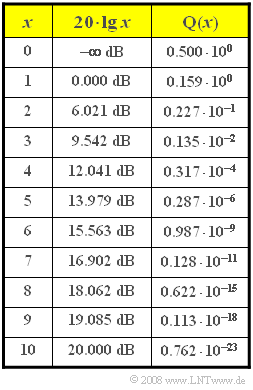Exercise 4.8Z: BPSK Error Probability
We assume the optimal baseband transmission system for binary signals with
- bipolar amplitude coefficients $a_ν ∈ \{-1, +1\}$,
- rectangular transmitted signal with signal values $±s_0$ and bit duration $T_{\rm B}$,
- AWGN noise with the (one-sided) noise power density $N_0$,
- receiver filter according to the matched filter principle,
- decision with optimal threshold value $E = 0$.
If nothing else is specified, you should assume the following numerical values:
- $$s_0 = 4\,{\rm V},\hspace{0.2cm} T_{\rm B} = 1\,{\rm ns},\hspace{0.2cm}N_0 = 2 \cdot 10^{-9}\, {\rm V^2/Hz} \hspace{0.05cm}.$$
Using the noise rms value $σ_d$ at the decision and the complementary Gaussian error function ${\rm Q}(x)$ the bit error probability of this baseband system is ⇒ see table:
- $$ p_{\rm BB} = {\rm Q}\left ( {s_0}/{\sigma_d } \right )\hspace{0.2cm}{\rm with}\hspace{0.2cm}\sigma_d = \sqrt{{N_0}/(2 \cdot T_{\rm B}}).$$
This bit error probability can also be expressed in the form
- $$p_{\rm BB} = {\rm Q}\left ( \sqrt{{2 \cdot E_{\rm B}}/{N_0 }} \hspace{0.1cm}\right )$$
where $E_{\rm B}$ indicates the "signal energy per bit".
The bit error probability of a comparable transmission system with Binary Phase Shift Keying (BPSK) is:
- $$ p_{\rm BPSK} = {\rm Q}\left ( {s_0}/{\sigma_d } \right )\hspace{0.2cm}{\rm with}\hspace{0.2cm}\sigma_d = \sqrt{{N_0}/{T_{\rm B}}}.$$
Notes:
- The exercise belongs to the chapter Linear Digital Modulation.
- Reference is made in particular to the section Error probabilities - a brief overview.
- The derivations can be found in the chapter Linear Digital Modulation - Coherent Demodulation of the book "Digital Signal Transmission".
- The specification of a power in $\rm V^2$ or an energy in $\rm V^2 s$ means a conversion to the reference resistance $1 \ \rm \Omega$.
Questions
Solution
- $$\sigma_d = \sqrt{\frac{N_0}{2 \cdot T_{\rm B}}}= \sqrt{\frac{2 \cdot 10^{-9}\,{\rm V^2/Hz}}{2 \cdot 1\,{\rm ns}}}= 1\,{\rm V} \hspace{0.3cm} \Rightarrow \hspace{0.3cm}p_{\rm BB} = {\rm Q}\left ( {s_0}/{\sigma_d } \right )= {\rm Q}(4)\hspace{0.15cm}\underline {= 0.317 \cdot 10^{-4}}.$$
(2) For the baseband system:
- $$E_{\rm B} = s_0^2 \cdot T_{\rm B}= (4\,{\rm V})^2 \cdot 10^{-9}\,{\rm s}\hspace{0.15cm}\underline {= 1.6 \cdot 10^{-8}\,{\rm V^2s}}.$$
- Of course, the second equation given gives the exact same error probability
- $$ p_{\rm BB} = {\rm Q}\left ( \sqrt{\frac{2 \cdot E_{\rm B}}{N_0 }} \hspace{0.1cm}\right ) = {\rm Q}\left ( \sqrt{\frac{2 \cdot 16 \cdot 10^{-9}\,{\rm V^2s}}{2 \cdot 10^{-9}\, {\rm V^2/Hz} }} \hspace{0.1cm}\right ) = {\rm Q}(4)= 0.317 \cdot 10^{-4}.$$
(3) When the transmitted amplitude is half $s_0 = 2\,{\rm V}$ the energy per bit decreases to one-fourth and the following equations apply:
- $$ p_{\rm BB} = {\rm Q}\left ( \frac{s_0}{\sigma_d } \right )= {\rm Q}\left ( \frac{2\,{\rm V}}{1\,{\rm V}} \right )= {\rm Q}(2)= 227 \cdot 10^{-4},$$
- $$ p_{\rm BB} = {\rm Q}\left ( \sqrt{\frac{2 \cdot E_{\rm B}}{N_0 }} \hspace{0.1cm}\right ) = {\rm Q}\left ( \sqrt{\frac{2 \cdot 4 \cdot 10^{-9}\,{\rm V^2s}}{2 \cdot 10^{-9}\, {\rm V^2/Hz} }} \hspace{0.1cm}\right ) = {\rm Q}(2)\hspace{0.15cm}\underline {= 227 \cdot 10^{-4}}.$$
(4) Answer 2 is correct:
- Considering the energy $E_{\rm B} = s_0^2 · T_{\rm B}/2$ we obtain
- $$ p_{\rm BPSK} = {\rm Q}\left ( \frac{s_0}{\sigma_d } \right )= {\rm Q}\left ( \sqrt{\frac{s_0^2 \cdot T_{\rm B}}{N_0 }} \hspace{0.1cm}\right ) = {\rm Q}\left ( \sqrt{\frac{2 \cdot E_{\rm B}}{N_0 }}\hspace{0.1cm}\right ).$$
- Thus, the same result is obtained as for the optimal baseband transmission system.
(5) Exactly the same results are obtained as for the baseband transmission in questions (1) and (3):
- $${ E_{\rm B}}/{N_0 }= 8: \hspace{0.2cm}p_{\rm BPSK} = {\rm Q}(\sqrt{16}) = {\rm Q}(4)\hspace{0.15cm}\underline {= 0.317 \cdot 10^{-4}},$$
- $$ { E_{\rm B}}/{N_0 }= 2: \hspace{0.2cm}p_{\rm BPSK} = {\rm Q}(\sqrt{4}) = {\rm Q}(2)\hspace{0.15cm}\underline {= 227 \cdot 10^{-4}}.$$
